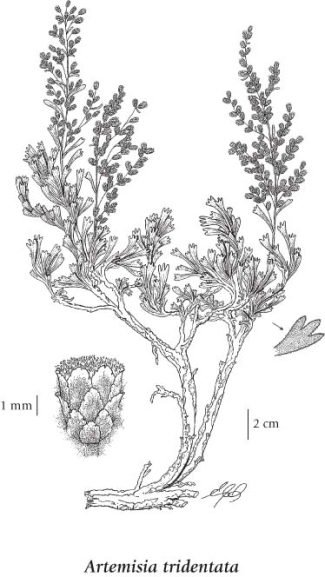Artemisia tridentata Nutt.
big sagebrush
Asteraceae (Aster family)
Introduction to Vascular Plants
big sagebrush
Asteraceae (Aster family)
Introduction to Vascular Plants
SUBTAXA PRESENT IN BC
Species Information
General:
Perennial, aromatic, evergreen shrub; stems solitary or branched from the base with shredding, grey or light brown bark when older, or with a dense, grooved, white-woolly hairiness when young, 0.1-2.0 m tall.
Leaves:
Principal leaves unstalked or short-stalked, silvery-hairy, typically wedge-shaped with 3 blunt teeth at the tips or sometimes 4-9 toothed or shallowly lobed, 1-4 (rarely 6) cm long, 2-13 mm wide.
Flowers:
Heads discoid, numerous in a narrow to broad inflorescence; involucres narrowly bell-shaped, 3.0-3.8 mm tall; involucral bracts elliptic to obtuse, greyish-hairy; receptacles glabrous; female flowers absent; disk flowers 3-6, sometimes up to 12 at higher elevations.
Fruits:
Achenes resinous-granular, rarely short-hairy.
Notes:
Recently, the var. wyominensis Beetle & A. Young has been reported in BC. At the present time, however, our material has not been studied with respect to this variety thus only our two traditional varieties are recognized here. They may be distinguished as follows:
1. Involucres narrowly bell-shaped, about 4 mm tall and 2 mm wide; plants of arid sites in the steppe and lower montane zones ..... var. tridentata
1. Involucres broader, about 5 mm tall and 4 mm wide; plants of cooler, mesic open sites in the upper montane and subalpine zones ..... var. vaseyana (Rydb.) Boivin
Illustration

If more than one illustration is available for a species (e.g., separate illustrations were provided for two subspecies) then links to the separate images will be provided below. Note that individual subspecies or varietal illustrations are not always available.
Illustration Source: The Illustrated Flora of British Columbia
USDA Species Characteristics
Flower Colour:
Yellow
Blooming Period:
Mid Summer
Fruit/Seed characteristics:
Colour: Brown
Present from Summer to Fall
Source: The USDA
Ecology
Ecological Framework for Artemisia tridentata
The table below shows the species-specific information calculated from
original data (BEC database) provided by the BC Ministry of Forests and Range.
(Updated August, 2013)
The table below shows the species-specific information calculated from
original data (BEC database) provided by the BC Ministry of Forests and Range.
(Updated August, 2013)
| Site Information |
Value / Class |
||
|
Avg |
Min |
Max |
|
| Elevation
(metres) |
634 | 175 | 2028 |
| Slope
Gradient (%) |
29 | 0 | 360 |
|
Aspect (degrees) |
190 | 0 | 360 |
| Soil
Moisture Regime (SMR) [0 - very xeric; 4 - mesic; 8 - hydric] |
2 | 0 | 7 |
| Modal
Nutrient Regime
Class |
C | ||
| #
of field plots species was recorded in: |
742 | ||
| Modal
BEC Zone Class |
BG | ||
|
All BEC Zones (# of stations/zone) species was recorded in |
AT(8), BG(511), BWBS(1), ESSF(3), IDF(77), MS(7), PP(119), SWB(1) | ||
|
Source:
Klinkenberg 2013
|
|||
Habitat and Range
Dry to mesic meadows and slopes in the steppe to subalpine zones; common in SC BC, rare in SE BC; E to AB and S to ND, NM, AZ, and CA.Synonyms
Synonyms and Alternate Names:
Artemisia spiciformis Osterh.
Artemisia tridentata subsp. trifida (Nutt.) H.M. Hall & Clem.
Artemisia tridentata var. parishii (A. Gray) Jeps.
Artemisia tridentata var. spiciformis (Osterh.) Dorn
Artemisia trifida Nutt.
Seriphidium tridentatum subsp. parishii (A. Gray) W.A. Weber
Seriphidium tripartitum (Rydb.) W.A. Weber